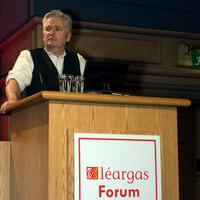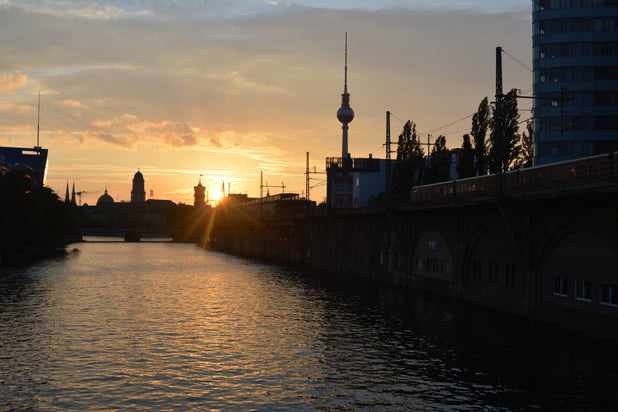Bringing learning from Berlin to Ballymun with Erasmus+
Alex O'M ahony is a primary school learning support teacher at Holy Spirit Boys’ National School in Ballymun. As he explained in a TED-type talk at the 2016 Léargas Forum, while the school has excelled in many ways it has always been challenging "to give our kids levels of numeracy and literacy which mean when they leave our school and go to secondary that they are highly likely to have a chance to go to university". The school used Erasmus+ KA1 funding to address this need, and as part of the project Alex looked at ways to integrate non-English speaking refugees into the school. He identified Berlin, which had recently taken in a large number of refugees, for a job shadowing visit and writes about his experience here. Watch his talk to learn more or follow him on Twitter.
ahony is a primary school learning support teacher at Holy Spirit Boys’ National School in Ballymun. As he explained in a TED-type talk at the 2016 Léargas Forum, while the school has excelled in many ways it has always been challenging "to give our kids levels of numeracy and literacy which mean when they leave our school and go to secondary that they are highly likely to have a chance to go to university". The school used Erasmus+ KA1 funding to address this need, and as part of the project Alex looked at ways to integrate non-English speaking refugees into the school. He identified Berlin, which had recently taken in a large number of refugees, for a job shadowing visit and writes about his experience here. Watch his talk to learn more or follow him on Twitter.
Imagine being the leader of a local authority. You are told that 100,000 men, women and children are coming to your city, and most of them will not be able to speak the local language. Now imagine you are in charge of education provision in that city, and you need to integrate a large number of these children into your education system. What would you do? How would you best meet the needs of these children, while continuing to maintain a high standard of education for children currently in your schools?
Well, this was the challenge faced by Berlin City Council in 2015. As part of my school's Erasmus+ project, I recently had the opportunity to speak with the woman whose job it is to oversee the integration of thousands of refugee children into the Berlin education system, Frau Gudrun Schreier.
'A Humanitarian Crisis'
Frau Schreier explained to me that the situation in summer 2015 was a humanitarian crisis. Coach loads of refugees were arriving in Berlin on a daily basis. Berlin City Council, in partnership with many voluntary groups, had to respond firstly by providing food and emergency accommodation in sports halls, churches and so on before moving onto meeting the wider needs of the new arrivals. The challenge faced directly by Frau Schreier and her team was how to deal with the educational needs of the thousands of newly arrived children. She told me that their underlying principle was ‘Sprache Als Schlüssel Zur Integration’-- ‘Language as the key to integration’. This means that language acquisition is seen as vital to the successful integration of refugee children into the life of a school and wider society. Therefore, it is a priority that each newly arrived child is taught, as quickly as possible, to understand, speak and write in German. To turn this principle into a reality, the decision was taken to promote and support the provision in local schools of “Willkommensklassen” (Welcome Classes).

What are 'Welcome Classes'?
Willkommensklassen are special classes within a school which are made up purely of non-native speaking children, who initially have little or no knowledge of German. They are situated in mainstream schools and their principal function is language acquisition. They have a pupil:teacher ratio of 12 to 1. All class teachers hold, or are in the process of gaining, a specific qualification in teaching German as a second language. The goal of the Willkommensklassen is that within 6 to 12 months 90% of the children will have a high enough standard of German to be able to transfer to a Regelklasse (mainsteam class).
It is not intended for children attending Willkommensklassen to be completely isolated from other German-speaking children within a school. Rather, it is expected that they would attend Regelklassen for lessons such as Music and P.E. and mix with other children during break times and after school activities. As of July 2016 there were 1,004 Willkommensklassen in Berlin, and a total of 12,191 children in such classes. Of that number approximately 50% were primary school aged children.
However, not all primary school aged refugee children must attend Willkommensklassen. Children under the age of eight go directly into a Regelklasse. This is because in Berlin children begin school at six, with the first two years (Schulanfangsphase) seen as preparation for formal learning. Given this perspective, it is felt possible to help children develop their language skills within a Regelklasse. In addition, any child who is over eight and has acquired an appropriate level of German can enter directly into a Regelklasse. In both of these cases it does not mean that a child no longer requires language support, but it is considered that the child’s additional needs can be met through the regular learning support mechanisms within a school..jpg?width=384&name=Alex%20Poster(1).jpg)
How, where and how quickly are Willkommensklassen established?
Frau Schreier explained that she holds a meeting at the beginning of each month and reviews the number of refugee children who have recently arrived in Berlin and where they are living. Then in co-operation with the 12 Berlin District Authoritities they identify the school places required in each district, and identify the schools where a Willkommensklasse can be established. The schools are then informed that a class will be set up in their school. The City Council ensures that the physical requirements of the school are met, and teaching staff are recruited. It is possible to establish such classes within a couple of weeks of the initial monthly meeting.
When a refugee family arrives in an area they must register with the District Authority. As part of the registration processes all children receive a medical examination and a language test. Following this, the children are allocated a place in a local school. Their age and level of German determines if they will go into a Regelklasse or a Willkommensklasse.
A great deal of freedom is given to individual schools about how the Willkommensklassen operate. The school decides what is taught in the Willkommensklasse, and which lessons a child will attend in Regelklasse. The school also determines when a child has reached a sufficient level of German to transition full time to a mainstream class.
To support schools in this time of crisis, Berlin City Council has expanded the support it offers in terms of access to psychological services and general social services support. In addition the Berlin Zentrum für Sprachbildung (Berlin Centre for Language Education) is now offering a much extended range of training to teachers, to help them identify and meet the education needs of the new arrivals. Refugee children receive free travel passes, free school meals and financial support to purchase school materials. Furthermore, Ferienschulen (Holiday schools) have been set up during school holidays so children can continue to have opportunities to improve their German throughout the year.
'Teachers are the driving force'
Finally, Frau Schreier pointed out that it was teachers themselves who were the main driving force behind the provision of Willkommensklasse for newly arrived non-German speaking children. The idea of such classes is not new in Berlin and similar classes existed from 1971 to 2007. From 2007 onwards, language acquisition was intended to take place within Regelklassen and schools were given additional support. However, as the numbers of non-German speaking children coming to Berlin began to rise, teachers in Regelklassen began to argue that the ad hoc arrival of such children placed too many pressures on them. Teachers felt that they were inadequately resourced to meet the needs of such children, and maintain education standards for existing class members at the same time. It was for this reason Willkommensklassen were reintroduced in 2011.
I will be returning to Berlin to speak directly with teachers and observe the day to day realities of Willkommensklassen. Along with other staff in the school who have given incredibly positive reviews of their own Erasmus+ courses, I will begin introducing what I have learnt into my own classroom.
Images courtesy of Alex O'Mahony. We welcome contributions to 'Insights' at comms@leargas.ie.

